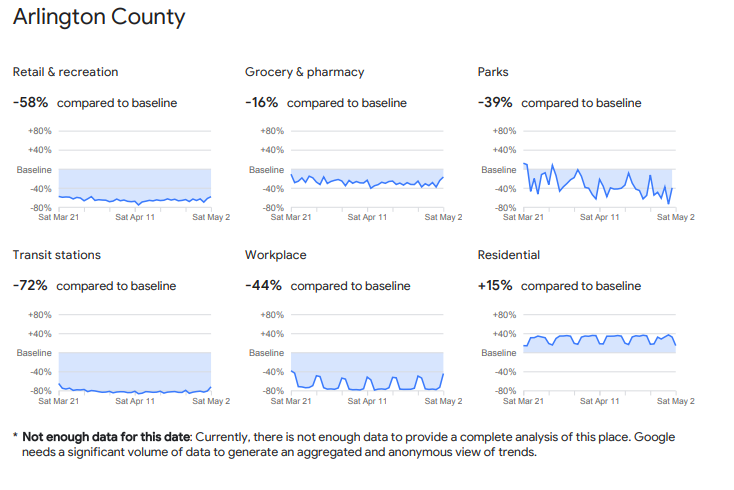Around the beginning of April, Google released the first “Community Mobility Report” for each US state, as well as for every country for which data exists. The report utilizes Google Maps data to determine the change in activity in certain regions over a baseline. For each jurisdiction, Google analyzes the change in movement within certain predetermined zones:
- Retail & recreation
- Grocery & pharmacy
- Parks
- Transit stations
- Workplace
- Residential
For almost every jurisdiction, we can see the predictable drop-off in activity in areas that are most directly affected by the lockdown (Retail & recreation, Transit Stations, and Workplace showing declines) and a corresponding increase in activity in residential areas as more people stay at home.
However, as you search through the data for your region, you may find significant discrepancies in activity in the outlying area ‘Parks.’ In places in which sufficient data has been collected, we can often see enormous differences between states, with some areas showing massive increases in attendance at parks, whereas others show declines. Consider the difference between Arlington County, VA and Bell County, TX.


Looking through the data, it strikes me that rural counties are much less likely to witness steep declines in retail areas due to any lockdown policies. Moreover, we can also see that park activity is down in affluent urban neighborhoods, whereas rural areas see wavering park activity or even steep increases.
At first glance, we can think of several explanations:
- What Google designates as a ‘park’ is much different in reality between different regions. In urban areas, parks are small, designated spaces in which one is likely to encounter other people. In rural places, parks are wider, less defined spaces offering greater distance between persons. In fact, your home might not be located in a ‘residential’ place at all but rather in what appears to be a ‘park.’
- Rural areas being more conservative overall, residents might be more skeptical of lockdown policies and instead may consider parks as a safe alternative to staying indoors.
- Rural residents need to travel through ‘park’ areas to get from one place to another, which may register as ‘park’ activity under Google’s analysis.
Another observation is that these rural areas see much less significant declines in activity toward workplaces and retail areas. Again, this may be attributed to the overall lack of ‘urban’ areas to begin with, so it may be less likely to avoid pockets of ‘retail’ spaces when traveling between one place and another.
It would be interesting to use this data to explore the hypothesis that conservative regions are violating stay-at-home orders. At first glance, we could compare Vermont and West Virginia: Both are generally rural places, but the blue state is seeing larger declines in retail (-40%), while WV is down only 22%, with both areas being up in park activity (although very volatile). Perhaps someone could compare this data set to political opinion polls.
